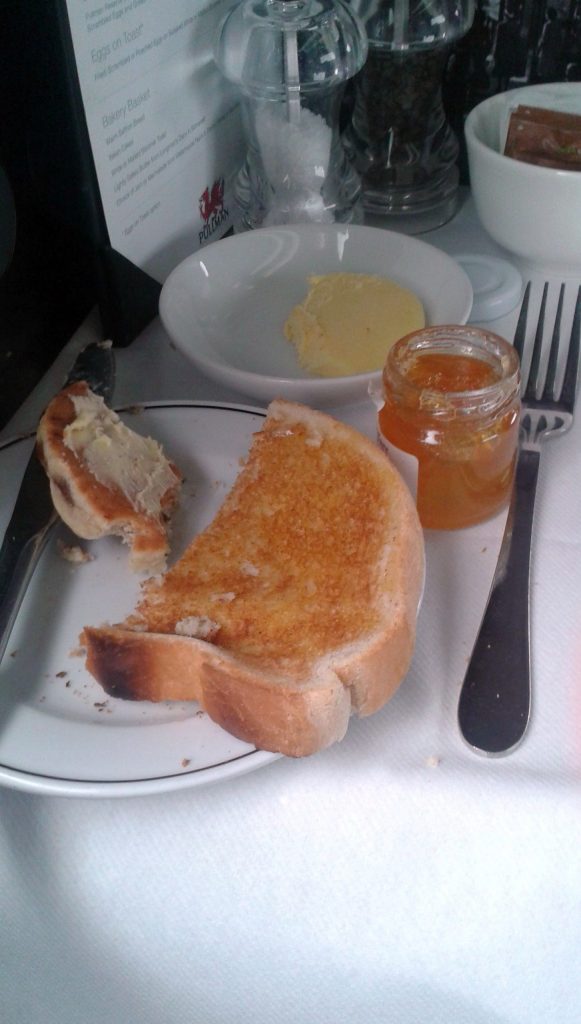Availability and Prominence of information on train catering
Does it affect your journey decisions?
On-train catering on scheduled train services in Great Britain can be superb, really a reason to make the effort to choose to travel on a particular train operator (TOC) or train. For example, a while back I needed to travel from BR Fares HQ in Reading to Cardiff. I managed to time my meeting in Cardiff so that I could take the 11:12 train from Reading, which I knew offered a full restaurant breakfast service.
My planning was rewarded with a delicious breakfast of porridge with honey, a full fry, toast, Welsh cakes and other delicious bread with butter and preserves, orange juice and unlimited tea.
Of course it wasn’t free; as I recall it cost £18 on top of the standard class fare. But for a breakfast of such quality that’s a fair price, and in any case it was cheaper than an upgrade to 1st Class on the same train, yet I received 1st Class service for the entire journey (normally, I would have needed to return to Standard after finishing my meal, but the service was leisurely and my breakfast lasted nicely for the 95-minute journey from Reading to Cardiff Central).
How did I know such good catering was available on this train?
Anecdote and rumour, more than anything. The GWR Pullman service provided on certain long-distance trains to and from London Paddington (which this was an example of) has become legendary as Britain’s last remaining traditional silver-service restaurant operation on scheduled mainline trains.
If I didn’t have any prior knowledge, would I still have chosen the 11:12 train?
Probably not. The preceding train at 10:42 typically has advance fares available at the same price, and offers a more convenient arrival time in Cardiff for a lunchtime meeting. If I’d discovered details of the restaurant service while booking, I could well have been swayed in favour of making my journey half an hour later. But in my opinion it’s quite likely that I would never have found out about the restaurant service on the 11:12, if I hadn’t already known about it. The key issue here is that on-train catering is generally not prominently advertised at the point of sale, i.e. when passengers are browsing journey options and purchasing tickets. Below are a few examples:
GWR Website
GWR’s own website provides some information, but it’s not very prominent or detailed. The main journey plan view shows a selection of itineraries, with departure and arrival times, number of changes, duration and the price of the cheapest standard class fare all prominently displayed. There is nothing to indicate the 11:12 departure offers exceptional on-board catering unless the user clicks the little ‘i’ icon next to the price. This brings up the information panel shown below:
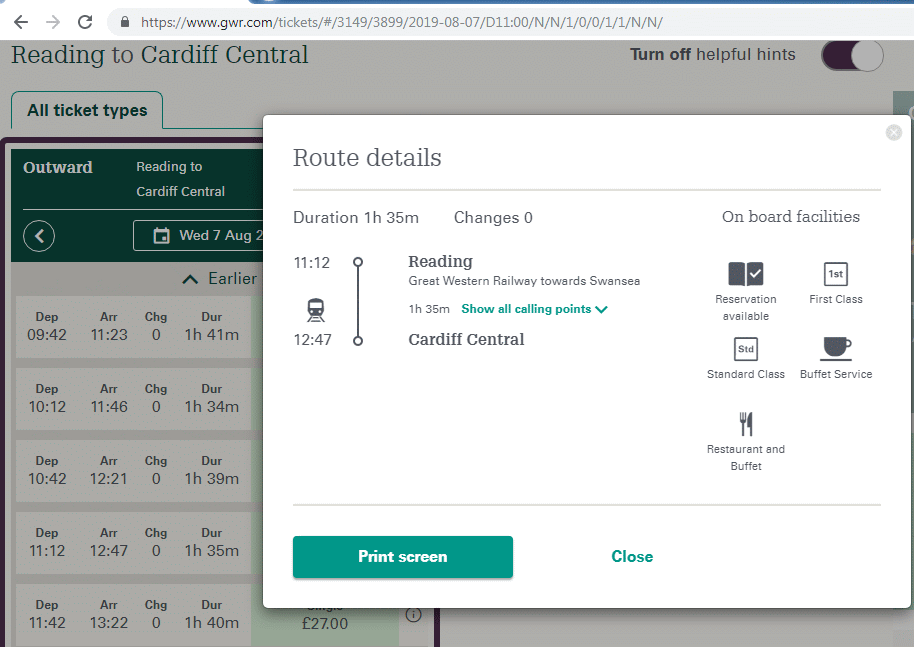
It shows a “knife & fork” symbol, with the words “Restaurant and Buffet” underneath. A couple of minor criticisms:
- The words “and Buffet” are superfluous, as a separate “cup & saucer” symbol with the words “Buffet Service” is displayed adjacently
- The train doesn’t actually have a buffet counter service, but this is a separate issue (regarding accuracy) which I will return to later!
If the intending passenger knows that there might be a restaurant service, and is prepared to spend some time clicking the ‘i’ icon against different itineraries in order to find it, they won’t go wrong. It could be easier, but it’s not the worst.
Ironically the GWR website actually has a great page about the Pullman restaurant service with full details of the trains on which restaurant service is available, links to menus and even an online booking form to reserve a table on busy services (only possible if you will be travelling on a 1st Class ticket). But if you were just planning a journey on one of those trains, you would not be given a link to this page, nor any detail about what “Restaurant and Buffet” means, so you might never know!
Trainline Website
The situation with Trainline is easy to summarise; it provides absolutely no information on on-board catering at all, neither on its website nor in its app. The journey plan view shows the same information as the GWR site, with the addition of the price of the cheapest 1st Class fare, which is helpful, but clicking on “0 changes” to bring up further information shows only the panel below:
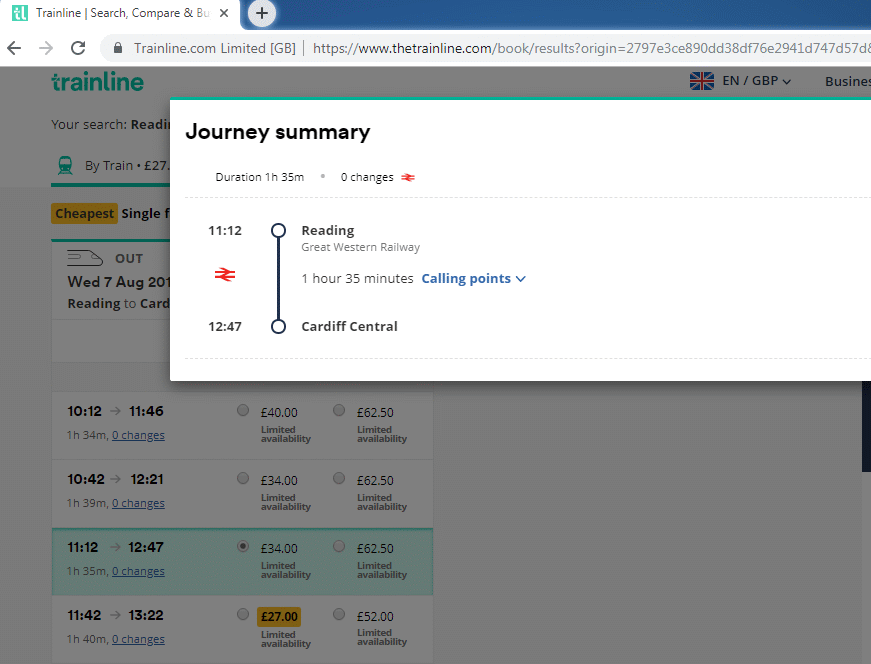
There’s a big white space with lots of room for detailed information about on-train facilities, but it’s completely blank!
In summary, an intending passenger using Trainline would have no idea the restaurant service existed and no way to find out.
BR Times Website
For completeness, the following screenshot from our own www.brtimes.com site shows how I’ve attempted to do my bit to make on-train catering information more prominent. To bring this up I requested all departures from Reading, filtered to show only those trains that call at Cardiff.
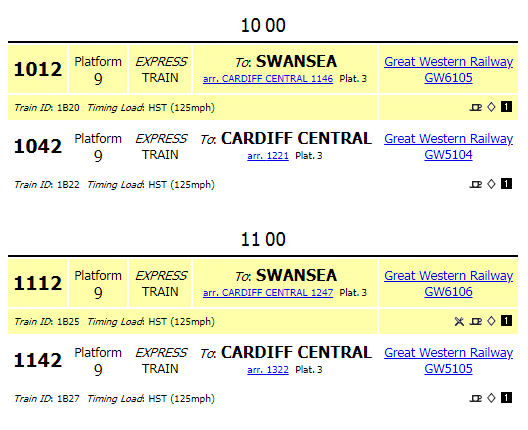
On the bottom right of each departure panel there is a set of symbols indicating the facilities available on each train. These are explained in more detail elsewhere, but in brief:
‘1’ in black box = 1st Class accommodation;
diamond = reservations available;
cup & saucer = buffet counter;
knife & fork = restaurant service.
This is far from perfect because there is no information on what “restaurant” actually means in this instance, but at least one can see at a glance the facilities on each train, and see that the 11:12 is distinguished by offering a restaurant when the trains either side do not.
GWR Printed Timetable
GWR’s printed timetable book costs £8 and is available at the ticket office at various key stations served by GWR, including Reading. The key advantage it has over an online journey planner (e.g. as used by the GWR and Trainline websites) is that it shows all journey opportunities on a given route at a glance, laid out in tabular format across the page:
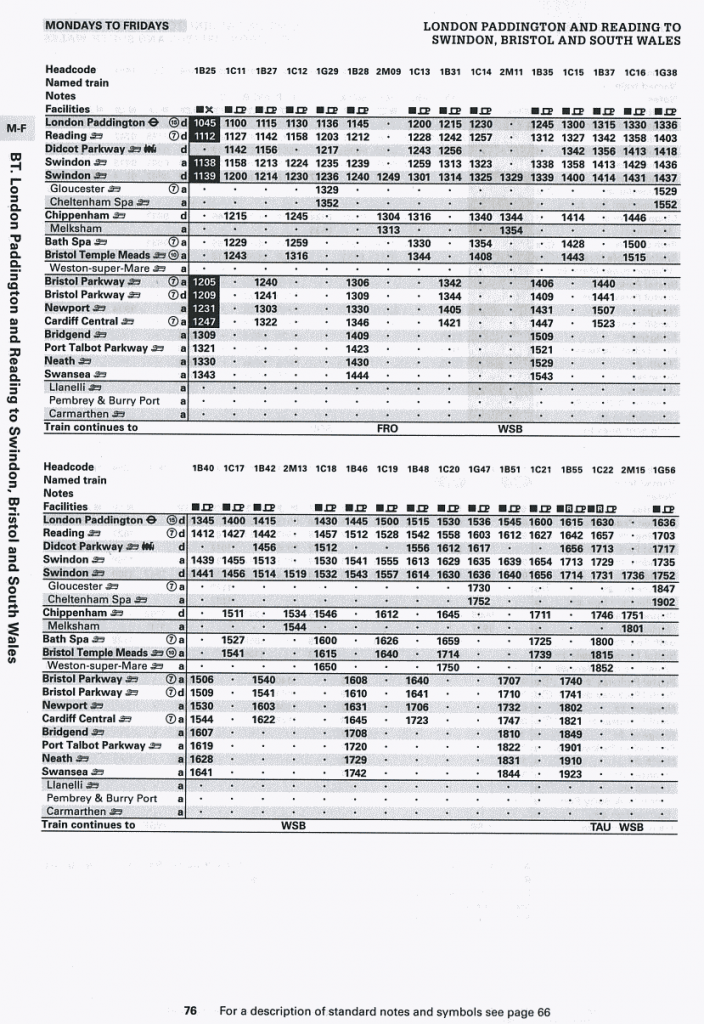
It also includes additional information that doesn’t feature prominently (or at all) in online journey planners. There is no technical reason why it’s not there; it just isn’t. Of relevance to this discussion is that the availability of on-train catering is shown for every train by means of symbols at the top of each schedule: “knife & fork” for restaurant service, “cup & saucer” for buffet counter.
Looking at the table for Paddington to South Wales journeys (above), the eye is immediately drawn to the 10:45 service from Paddington, (11:12 from Reading), as the departures times are highlighted with a dark green shading – indicating that there is something special about this train. Another couple of seconds study will reveal that the main difference for that train is the “knife & fork” rather than “cup & saucer” at the top of the column. A cross-reference to page 66 encourages the reader to look up the symbols there, where we see the following detailed information on the restaurant:

Perfect!
Consistency of information on train catering
GWR and the disappearing buffet counters
So far we’ve discussed how information on on-train catering can be more or less prominent, or not available at all, depending on the channels through which one obtains the information. If the information is to be used by passengers in planning their journeys, as well as being available and prominent, it is also very important that the meaning is clear and consistent. In one way, the GWR printed timetable is a good example of this – as it only publishes details of its own services, it can be specific with the details as they apply to it.
But it’s also one of the worst examples, for a lack of consistency! A particularly odd one is that, as shown above, the description for the “cup & saucer” symbol is given as On-train refreshments are available for all or part of the journey. This goes against the traditional meaning, used everywhere else as far as I can see, of Buffet counter service of hot & cold snacks, sandwiches and hot & cold drinks is available. Indeed, GWR’s own website uses the latter description!
Regular travellers on GWR intercity services may know that, over the past year or so, all the old InterCity 125 High Speed Trains have been replaced by new Intercity Express Trains (IETs), none of which are fitted with a buffet counter. So in fact it’s impossible for the trains to offer a buffet service, and the description in the timetable is the correct one.
The trains now have a trolley service instead. There is a well-established conventional symbol of a stylised “trolley” with the meaning At-seat trolley service of cold snacks, sandwiches and hot & cold drinks is available, so I wonder why don’t GWR use this? Was it too much work to change all their train schedules to show a trolley service instead of a buffet, so they decided to change the meaning of the “cup & saucer” symbol? Are they embarrassed at the substantial downgrade in service (to be fair, imposed upon them by the government) resulting from the design of the IET train, and didn’t want to draw attention to it? I’d really love to know why!
Despite the admirable attempt to smooth things over by changing the meaning of the “cup & saucer” symbol, the decision to keep on using it for trains that now only offer only a trolley service has resulted in some very messy inconsistency, e.g. for the following journey from Reading to Swansea (from GWR’s own website):
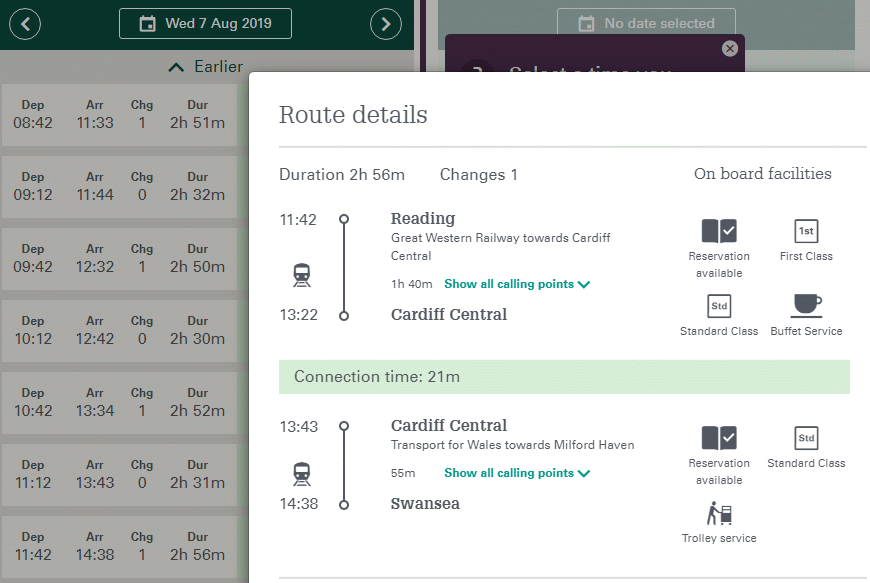
This shows a buffer counter available for the first leg of the journey from Reading to Cardiff and a trolley service available for the second leg from Cardiff to Swansea. The second leg is operated by Transport for Wales Rail, which does still use the trolley symbol to mean trolley service!
Variations in catering “offering” between TOCs
The general range of products offered from a buffet counter and trolley service respectively remain generally similar between those TOCs that offer such a service. The buffet may have a different name, e.g. for the last few years of its existence on their trains GWR called it the “GWR Larder”; Virgin call it the “Shop”. But generally it will sell sandwiches, biscuits and sweets, hot and cold drinks including alcohol, along with basic hot options such as toasted sandwiches, soup or porridge. A trolley will generally sell a more basic range of the same options, with the exception that there are no hot snacks, although sometimes at certain times of day you might be able to order a hot snack to be delivered to your seat. There is much wider variation in the 1st Class offering between TOCs.
Almost certainly I’ve over-generalised or left something out in the summary above, and in any case going into the detail of any of this is beyond the scope of this blog post (but watch this space!). However a useful page on National Rail Enquiries entitled Catering facilities on National Rail services makes a reasonable attempt to give a summary of the offering on each TOC, and is worth a look.
The same problem as noted above applies though: this information is totally divorced from, and appears to be maintained entirely separately to, the information on catering availability that is attached to each train schedule and displayed in online journey planners.
Technical Specification
Now is probably the most appropriate time to give a basic outline of the way in which catering information is associated with train schedules in the train planning database systems.
Technical note: the following discussion is based on what’s possible within the constraints of the Common Interface Format (CIF), i.e. the file format used for transferring details of train schedules between various rail industry computer systems. This is the format in which online journey planners, timetable publishing systems etc. all receive the data.
Each train schedule may have up to 4 “catering codes” associated with it, with the possible values and their meanings defined in internal standards documents as follows, and conventionally indicated by the (combination of) symbols shown:
| T | Trolley | |
| C | Buffet | |
| H | Hot Food & Buffet | |
| R | Restaurant & Buffet | |
| M | Hot or Light Meal (1st Class) & Buffet | |
| F | Restaurant (1st Class) & Buffet |
The available catering may change at any station at which a train stops during its journey. So for example a train from Penzance to Paddington may have a buffet counter available between Penzance and Plymouth, a restaurant and buffet available between Plymouth and Reading, and once again only a buffet counter available between Reading and Paddington.
Taken all together there’s a lot of flexibility in the way the variations in catering across a train’s journey can be described. And as far as I can see, the information is already there, so there’s no reason not to put it into the schedule. For example, the rosters for catering staff need to be planned in advance, so the TOC should know which trains it’s going to offer what catering on.
I think this should be true the vast majority of the time, anyway. I had an interesting conversation with a train planner a few years ago, who told me that for certain services operated by a certain TOC, the catering was sub-contracted to a 3rd party company, and that company’s staff decided themselves which trains they would operate a trolley service on, based on availability of staff and which trains they expected to be busiest and most profitable, etc. So while the TOC’s train planners did their best to put a ‘T’ (indicating trolley service) into the schedules of the trains they deemed more likely to have a trolley service, its provision was not contractual and so they couldn’t be sure the information was correct!
Symbols
I’d love to be able to say more about the history of the four basic symbols shown above and their meaning, but unfortunately I don’t know very much and can only give a brief overview of how they’ve changed between various timetables I have in my possession.
1986
The Summer 1986 British Rail Passenger Timetable uses only the “fork on a plate” and “cup & saucer” symbols and defines their meanings as follows:
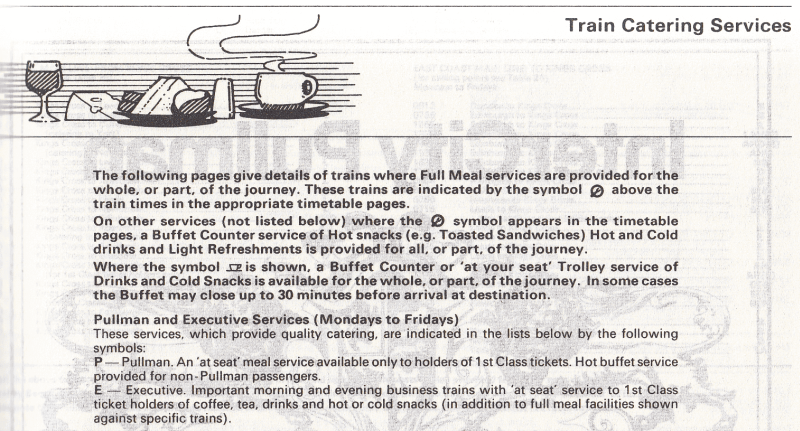
To summarise, “fork on a plate” means hot food is available, and there’s a separate list of all trains (running to over 2 pages) of all trains that offered a restaurant service. This isn’t particularly user-friendly as it requires a lot of cross-referencing. There is no trolley symbol, and “cup & saucer” has been downgraded from its more recent meaning to indicate only a buffet or trolley service, of drinks and cold snacks. I find it fascinating that this meaning from 1986 is the same meaning GWR has used in its most recent timetable!
1998
In the Summer 1998 Great Britain Passenger Railway Timetable, published by Railtrack, the list of catering symbols had evolved to the following:
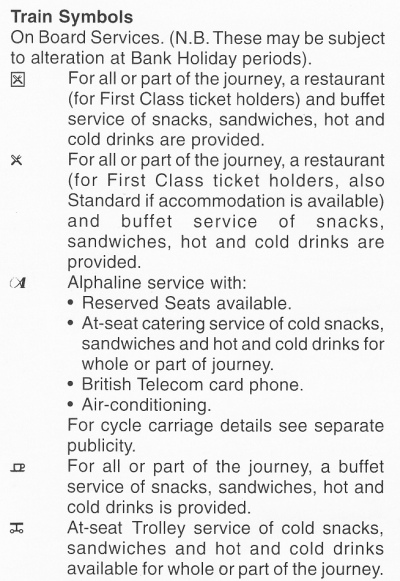
The “fork on a plate” symbol has disappeared completely, however the “knife & fork in a box” symbol has appeared to denote complimentary restaurant/meal service in 1st Class. The “trolley” symbol has been introduced and is used extensively. To complement this the meaning of the “cup & saucer” symbol has been changed such that it definitively indicates the presence of a buffet counter.
2019
Finally, the current Network Rail Electronic National Rail Timetable (2019) shows the catering symbols as follows:
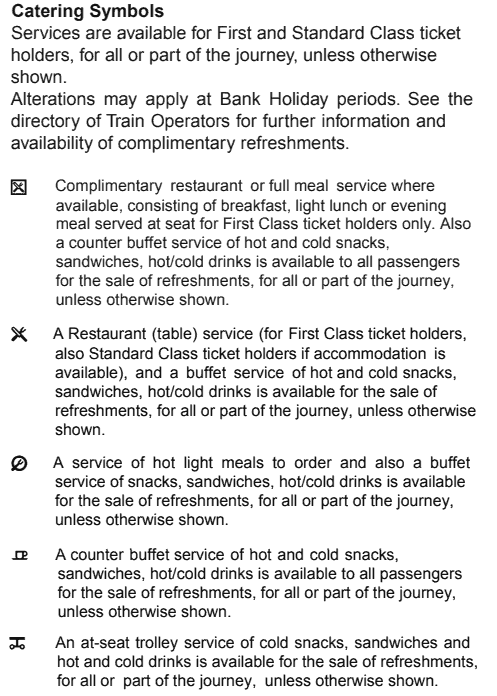
Of note is that the “fork on a plate” symbol, now denoting hot food available to order, has reappeared. The “cup & saucer” symbol has been yet again upgraded, indicating a buffet counter with hot snacks as well as cold snacks and drinks.
Do symbols matter?
Personally, I think it would be fighting a losing battle to try to keep the meanings of the standard symbols updated to reflect changes and variations in catering provision across different TOCs. The system was designed for a time when one company (British Rail) operated all trains and it was relatively easy for things to be standardised.
Also, there does need to be a basic assumption that a TOC wants to advertise the services it is offering. If it doesn’t, for example if the management fear liability under the Consumer Rights Act (travel amendments) for failing to provide the advertised catering, they may well be wary of allowing other operators, 3rd party retail and timetable sites etc. to advertise their catering offering.
There needs to be some consistency in meanings – but not the same meaning across different TOCs. Rather, the advertised catering (whether advertised by means of symbols, text, or images) needs to be consistent with what the TOC plans to offer. This is clearly in everyone’s interest.
I can think of two possible routes to achieving this aim:
- Greatly expand the number of catering codes to allow much more granularity and flexibility in the ways a TOC can describe its food and drink offerings in 1st and Standard Class.
As noted above, each train may have up to 4 different catering codes associated with it. Currently there are never more than two used, and only six possible values T, C, H, R, M and F, with H (hot food to order) not currently being used by any trains as far as I can see. With 26 letters of the alphabet and 10 digits 0-9 there are 30 more possible codes that could be used, giving lots of flexibility (if properly managed and controlled) for more detailed and granular information on catering. - Have an enhanced central database of catering provision on each TOC.
The list on National Rail Enquiries would appear to be a good start. Each entry in the list appears to be separately managed by the relevant TOC. The main problem is that because it’s a just a generic description, it can’t be tied in to individual trains. If instead it contained a description of what each TOC provided for each catering code, it would be so much more useful and could be tied into the output from journey planners.
Perhaps a combination of the two would be the best option, allowing introduction of a few separate codes that would be able to be shared by TOCs, because their database entries would be different. E.g. the restaurant (and 1st Class restaurant) codes could be different for breakfast, lunch and dinner. If co-ordinated properly, these could be displayed as the same “knife & fork” symbol in timetables, but the database entry could contain more details on the meals on offer, which could be automatically pulled in by journey planners and displayed to passengers to help them make a better-informed decision on their journey options.
Accuracy and Precision of catering information
The final theme I would like to make a brief comment on is that of accuracy and precision of the information. I’ve already commented on the fact that GWR’s website announces its long-distance trains as having a buffet counter when in fact they don’t. It also happens that some TOCs offer a good catering service but it’s not properly advertised, e.g. East Midlands Trains (EMT) offer their “All Day Menu”, a paid service of hot snacks and light meals, throughout the day in 1st Class. This is well advertised on their website (including menus), and shown commendably clearly in their printed timetables, but is not shown in national timetables nor any online journey planner (including that on EMT’s own website), because it isn’t in the schedule data.
I presume EMT don’t indicate it in the schedule data because there is no conventionally defined catering code for Hot or light meals available to purchase in 1st Class only, but as I noted above, there is plenty of scope for new codes to be added, and it’s a pity that the industry co-ordination that would enable this to be taken forward doesn’t exist (or so it seems to an outside observer, at least).
A similar criticism could be levelled at London North Eastern Railway (LNER) in terms of advertising of their 1st Class meal provision. Their website prominently advertises the Chef’s Signature menu enhanced dinner service available on various peak evening trains out of King’s Cross. Yet in the schedule data, they use the same code ‘M’ (Hot or Light Meal in 1st Class, “fork on a plate in a box”) on these trains as on all others, so there is nothing to distinguish them and let the intending 1st Class passenger know it’s worth making an effort to catch one of these trains. It would be more precise if they changed the code to ‘F’ (1st Class Restaurant, “knife & fork in a box”) on these trains so that journey planners and other industry systems could correctly advertise the enhanced catering available on these prime evening departures.
Finally, I wanted to draw attention to an example of good practice, in terms of precision. The standard catering symbols just note that a service may be offered for “some or all of the journey”. That is needlessly vague, especially since, as noted earlier, schedule data can include details of the stations at which the catering availability changes. This is particularly relevant to a TOC such as CrossCountry, which runs a relatively complex network of long-distance trains.
CrossCountry’s ticket buying system which, similarly to EMT’s, is operated for them by Trainline, provides absolutely no catering information at all. It’s ironic as many staff at the TOC have clearly put a lot of effort into providing detailed catering information. For example the main CrossCountry Food & Drink page includes menus, a detailed map showing the trains on which catering is available, and even a timetable of individual service on the ex-Central Trains “Turbostar”-operated routes on which catering is available.
For the core CrossCountry network, the catering availability is indicated exceptionally clearly in the printed timetable:
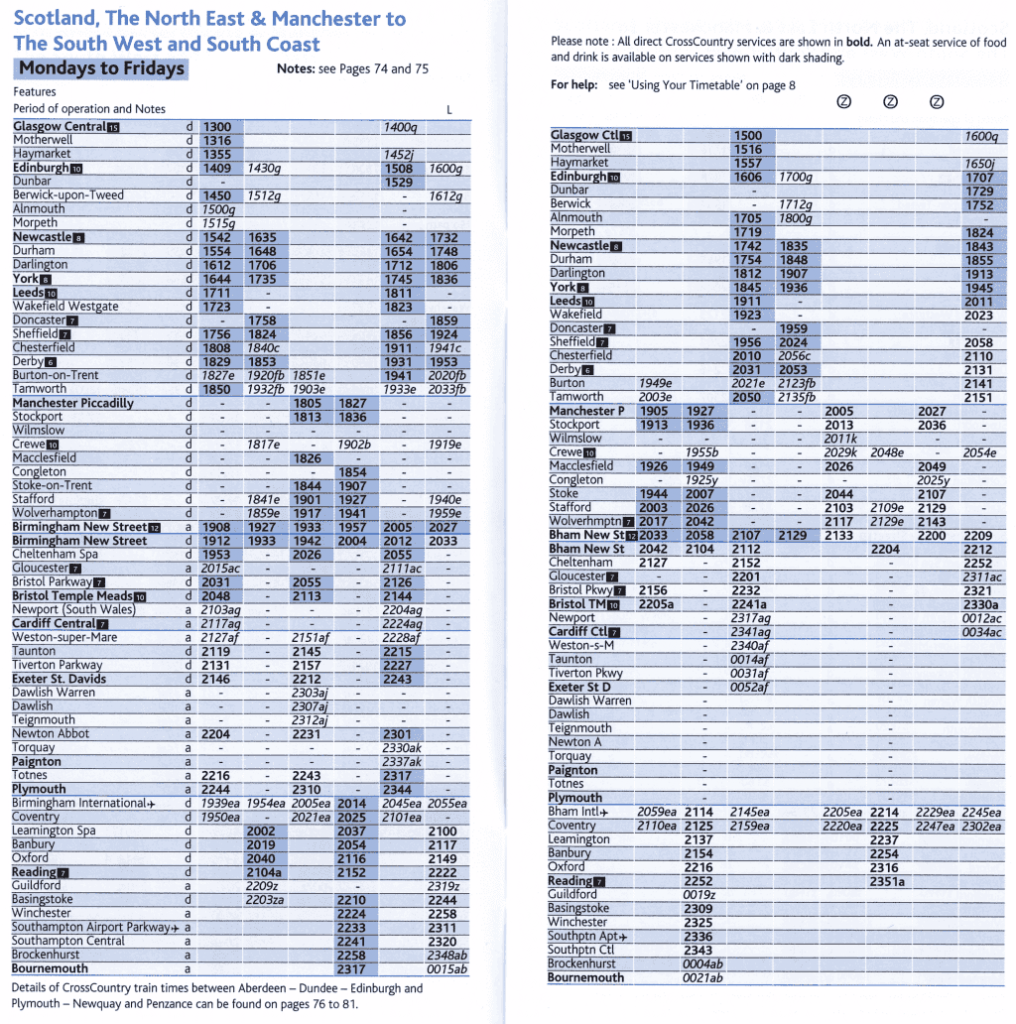
The departures on which catering is available are shown in dark blue shading. For example, I’m travelling from Newcastle to Birmingham, this allows me to see at a glance that if I catch the 18:35 service the catering is available right the way through to Birmingham, but if I’m on the 18:43 the catering provision ceases at Leeds, so I need to make sure to have obtained refreshments before then. The trains (generally late evening and early morning services) on which no catering is available at all have an additional ‘Z in a circle’ symbol at the top of the column indicating this, just in case the reader overlooked the lack of dark shading.
I think this has been done really well in the timetable and it’s a shame the journey planner on the CrossCountry website can’t follow suit.
Conclusions
I’ve shown how the advertising of on-train catering can be evaluated in terms of three criteria:
- Prominence
- Consistency
- Accuracy
The quality of information provision tends to vary by information channel/medium more than by TOC, yet there do not appear to be any good reasons for this. Online journey planners and printed timetables all source their information ultimately from the same electronic schedule data.
There is much scope to increase the range of catering “codes” to allow for more granular descriptions of the catering available, and the database of catering provision by TOC, already maintained by National Rail Enquiries, is a starting point that could be made into a great resource and tied in with journey planners and even timetables, if only it allowed each TOC to provide a different description for each catering “code” (i.e. T, C, H, R, etc.).
Ultimately I feel there needs to be more joined-up thinking between people involved in marketing, customer experience, train planning, timetable publishing and website and journey planner development. I’m very happy to do my bit to facilitate this if anyone has any suggestions for how we at BR Fares might be able to help.
Thanks for reading.

